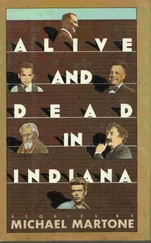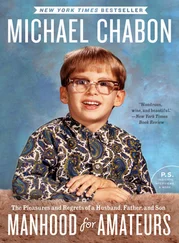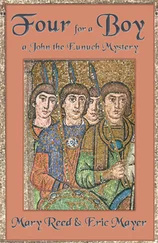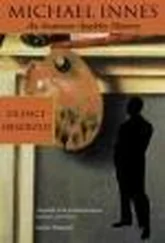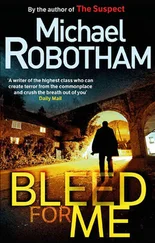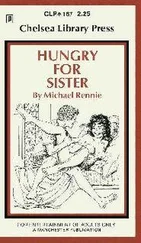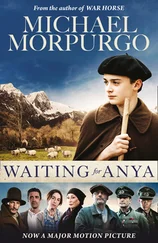Driving home, we went under the viaduct labeled with the drumhead logo of the B&O, the capitol dome in the blue circle. I asked him if he could name the thirteen great states the railroad connected to the nation. That took some time, and I was happy when he gave up because I could only count a dozen in my head. To keep him busy we played I Spy and I Went to My Grandmother's House. I showed him the high tension towers and told him those wires there go all the way to the power plant where I work. “It's all connected.“
In his pockets were chunks of metal and scrap he salvaged from the roundhouse — rusted rivets and wing nuts, amber glass, a brass toggle, a lump of coal. Later, back home, he arranged the pieces over and over again on the cement squares of the driveway. He was a strange kid. He'd stay busy for hours turning the geared wheel within the geared wheel that turned the grindstone I had bolted to the workbench in the garage. He said he liked to see how they, the teeth he meant, fit together to make it all go.
READING
It opens like a book, made of tin, and all the tiles, each printed with a single letter and its parasitic subscript, are magnets that cling to the grid so that, later, when I get mad about all the words I do not know or could not guess or cannot remember, I can't toss the board over, spilling the tiles and scrambling that game's particular accumulating network of cross-words. It is a travel edition. The train I am traveling in is yawing, and this stretch of old rail still wields unwelded joints. The car skips and shutters. The compartment's above a six-wheeled truck that transmits the stammer through the old heavy metal. One reading light falls on the open game with its sticky scales of letters. The other reading light falls over her shoulder, kicking up dust in the beam, to light on the book she is reading, reading while I take my turn.
I have drawn all vowels, it seems, and most of those are Os. There is a moon outside I can see through the faint reflection of my face in the smeared window, and I can see what look like scattered cattle, black and white, lolling in the gloaming. But here before me, there isn't a tail end of an M on the board to let me couple on an O or two.
I watch her read. Her eyes scan a rhythm that seems to syncopate with the backbeat of the train's. She is reading a travel book. There are no Bs or Ks, no book or look or kook, to hook onto either end. No boo. A travel book about Greece I think — a blue train circling the Peloponnesus, the cog railway gearing up a gorge to Kalavrita.
Then, it happens. The moment when a word like the stops being the , the the-ness goes out of it. It's all Greek then. I can't make this or that mean anymore. That that will always stop me in my tracks as I read, coming upon this word this or this the or that the , some strange train wreck of letters, everything sprung, Sherman's twisted bowties knotted with the overheated rails. That's the way this game always feels to me. This impossibility that out of sheer arrangement came sense.
This is the point in the game I would usually hurl the cardboard board across the room, wooden tiles flying, but this particular travel edition has unified its fields of forces — strong, weak, magnetic, gravity — the four black engines of the universe. Things attract, stick, adhere, bond. I'll have to pass. She keeps on reading. She's in a carriage crossing the canal at Corinth, and she is here in some dark territory of Pennsylvania. The train's wheels, those Os, roll over the rail, a dime-sized connection, almost without friction. The whistle yodels an ordinary echo. Echo. Expanding rings of sound waver and warble.
Ordinary is ordinary again. I look at the board of crisscrossing letters, words, sentences, messages. The language chugs. This stands for this, I see. And this stands for this. And this for this. And this.
The First Four Deaths in My High School Class
STEVE HUBER
died in Randy Neath's swimming pool. He was electrocuted. A short in the wiring of the built-in lights. This happened years before we went to high school, but we think of him as part of the class. At the reunions, he is always listed as one of the dead on the memorial page of the program. Randy graduated. We talked about Steve at the last reunion. He played guard on my PAL basketball team. Randy's hair is still red, and he still lives in his parents' house. In the summers, he swims in the same pool where the accident happened.
HOLLY LOVE
died after she was out of high school and married. She might even have had a child by then. She was a high school teacher. Foreign languages. It was something sudden, something in her brain or in her heart, a clot or embolism. She had been in my class in grade school, where she was a lieutenant on the safety patrol. Her job had been to raise and lower the flag every school day. Her best friend growing up was Sheryl Faulkner, a neighbor, who went to Queen of Angels. Holly married Sheryl's brother. Sheryl's husband, Don Krouse, died in a car wreck on a county road. He was our age and would have been in our class, but he went to the Catholic high school instead.
JERRY KIRKPATRICK
died with AIDS, but he killed himself before the disease killed him. A gun. We had talked on the phone only a month before he died. This was after college, and he was living, then, in Atlanta. When I called, he was in the middle of refinishing a wooden door. He had just applied the chemical stripper, and he was letting it work while we talked. He said, “I'll let it work.“ We had met in junior high school. His real name was Ralph, but he went by Jerry. That caused some confusion when “Ralph Kirkpatrick“ was listed, in our reunion program, as one of the dead in our high school class.
FRITZ SHOEMAKER
died after killing his wife, Mary, who had been Mary Knight in high school. So, technically, Fritz was the fifth to die in my high school class. He shot himself with the same rifle he used to kill his wife, who I never knew. It was a large high school. There were over six hundred students in our one class. During commencement at the Memorial Coliseum, it took a while for all of our names to be read. We graduated when platform shoes were in style, and everyone in their shiny red gowns walked carefully up the stairs to the stage. Fritz played the accordion, wore glasses, and came to my eighth birthday party when we both were in Mrs. Hanna's third-grade class, where he sat, toward the back, near Debbie Saunders, Greg Street, and Mark Taylor.
1730 SPRING STREET
There is a porch across the full front of the house. The door is in the center. The living room is on the left as you go in with the stairs leading up in the back. The dining room is on the right with the kitchen and a little breakfast nook behind it. Upstairs, the hallway runs down the middle. Two bedrooms on the left and the bathroom with its tiled picture of a flamingo at the top of the stairs. The other bedroom, on the right toward the front, has a linoleum floor I watched my parents install, square by square, the same summer I learned to read there.
1815 ALABAMA AVENUE
There is a porch across the full front of the house. The door is to the right. The living room fills the front half of the ground floor. The dining room is on the left in back. The kitchen is behind the stairs rising from the center, up and to the right, to the landing and then switched back upstairs. There is a big bedroom above the living room and a bedroom behind it with a bathroom across the hall. And in the back, a sunporch, windows on three sides, that looked down on the backyard with clotheslines propped and diapers drying, frozen in the winter, sheets of white chocolate.
Читать дальше



